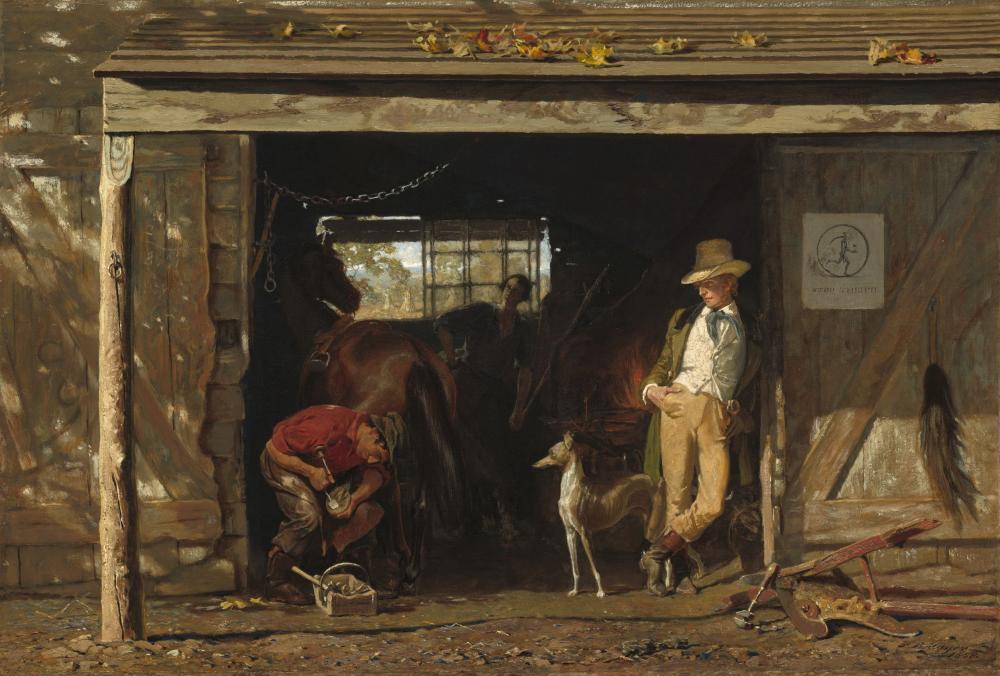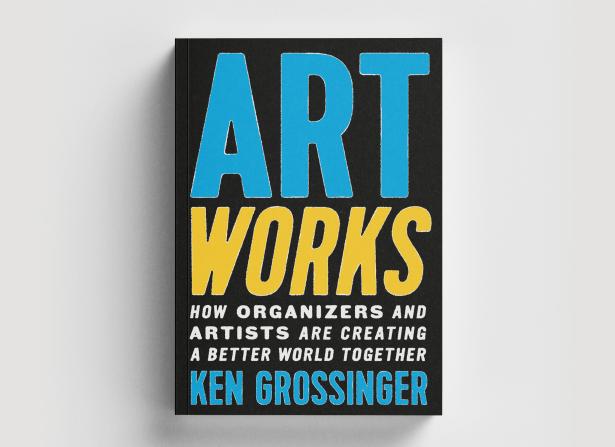Art Works: How Organizers and Artists Are Creating a Better World Together: A Review
What happens after Election Day 2024? The best answer I’ve seen comes from Art Works, by longtime organizer and strategist Ken Grossinger (https://www.artworksbook.com/).
Let me hasten to assure you that Art Works is not your usual political book, as evidenced by its subtitle, “How Organizers and Artists Are Creating a Better World Together.” This slim volume, I would argue, is the perfect handbook for the battles that are sure to come, no matter who wins in November.
Published just a year ago, Art Works is an inspirational read, deftly weaving together on-the-ground stories into Grossinger’s overall theme of the necessity of “fusing politics and culture.” Artist-activists, says Grossinger (who’s a longtime personal friend, dating back to when we both worked for the AFL-CIO), “tap popular culture to tell important truths” and have “played pivotal roles in virtually all movements for a more just and equitable society.” Among other cultural projects, he’s co-executive produced the award-winning Netflix documentaries The Social Dilemma and The Bleeding Edge. He was also director of Impact Philanthropy at Democracy Partners.
This idea of the power and central importance of art and culture is the animating spirit behind the Labor Heritage Foundation, which is celebrating its 40th anniversary this year, and where I serve as Executive Director. Yet when fundamentals like our very democracy are on the line, the arts can feel like a luxury and a distraction from life-or-death battles at the ballot box, in Congress, at the Supreme Court.
In just six gripping chapters replete with fascinating tales from the frontlines, Grossinger vividly illustrates how art and culture can actually have a more profound impact on society, noting that “The political pendulum keeps swinging, but a shift in public attitudes can make the gains harder to undo.” As the nation seems to be lurching toward another such swing, Art Works provides a timely reminder that a movement’s music, film, theater, and, yes, even our museums, are not “extras” to be set aside, but the very tools and weapons we need most. It nicely illustrates Margaret Mead’s maxim, "Never doubt that a small group of thoughtful committed individuals can change the world. In fact, it's the only thing that ever has."
The first chapter, “Freedom Is a Constant Struggle”, launches the book beautifully, quickly drawing the links from the Civil Rights movement six decades ago directly to today’s Black Lives Matter movement. Grossinger, who’s been a leading strategist in movements for social and economic justice for thirty-five years, writes like an organizer, with an impressive depth of knowledge that’s always used to move the story – and the argument – forward. A good example is the quote he uses to open the chapter, from Southern Christian Leadership Conference (SCLC) director Wyatt Tee Walker, describing the classic civil rights anthem We Shall Overcome.
“One cannot describe the vitality and emption this one song evokes across the Southland. I have heard it sung in great mass meetings with a thousand voices singing as one; I’ve heard a half-dozen sing it softly behind the bars of the Hinds County prison in Mississippi; I’ve heard old women singing it on the way to work in Albany, Georgia; I’ve heard students singing it as they were being dragged away to jail. It generates power that is indescribable.”
Without bogging down in historical minutia, Grossinger nimbly moves through the labor movement’s use of music in movements like Cesar Chavez’ farmworker organizing and Woody Guthrie and Pete Seeger performing in migrant worker camps, to the Black Arts Movement founded by Amiri Baraka, which “blended activism with poetry, theater and music to lift up Black revolutionary culture and Black pride,” and carrying through the Black Lives Matter movement, from which blossomed a thousand street murals of George Floyd and other victims of police brutality.
Perhaps nothing proves Grossinger’s argument about the lasting power of art than the proliferation of BLM pavement murals across the country, which in Washington, D.C., on 16th street across from both the White House and the AFL-CIO, is now etched, not in sidewalk chalk but stone letters that defiantly fill the street, which has been renamed “Black Lives Matter” plaza.
And that’s just the first chapter. Chapter 2, “Singing for Our Lives, covers “Music and Anthems for Our Planet”; the third chapter (which, as director of the annual DC Labor FilmFest I of course turned to first) is a terrific exploration of “The Power of Film in Political Mobilization, starting with the impact of The China Syndrome on the anti-nuclear movement, and then of course the hit 1980 film 9 to 5, starring Jane Fonda, Dolly Parton and Lily Tomlin, which helped build union power for women workers. In a telling echo of our own times, though, Grossinger notes that 1980 also brought Ronald Reagan and an ascendant right wing to power, “point(ing) up the need for organizations to defend their gains by advancing their electoral interests.”
Chapter 4 dives into “Cultural Strategies for Migrant, Immigrant and Refugee Justice, starting with the National Day Laborer Organizing Network (NDLON), “whose unique approach to organizing places art and culture at the heart of their strategies,” including hiring poets, musicians, a cartoonist and an illustrator for their staff.

Leisure and Labor, 1858 Frank Blackwell Mayer, Corcoran Collection (Gift of William Wilson Corcoran)
Through dozens of stories of local and national movements that successfully used music, film, theatre and art to advance their causes, Grossinger makes a convincing argument for the power of the arts. But I was skeptical of Chapter 5’s inclusion of museums in his brief; for most of us they’re places we obediently trekked through on school field trips, full of art we don’t understand and objects we’re forbidden to touch or distanced from us behind glass. Grossinger suggests another possibility, that museums and social justice advocates can work together and that “these new alliances can be a powerful driver of social justice narratives and can spur social change.” His lead case study is the New York-based Queens Museum of Art, which in 2006 hired an organizer to connect with the local community. The result was the transformation of Corona Plaza from a site for “small one-off museum-sponsored events and street fairs into a renovated public space and central location for the museum’s public art projects, community festivals, parks and advocacy work.” More crucially, the Plaza, in addition to art and culture, would offer community and health services.”
Another example is the Arizona State University Art program, which looks to build a “’sense of place,’ by reprioritizing people and their stories and giving objects the supporting role.” This reminded me that for many years, as part of the annual DC LaborFest, I organized tours of DC museums that revealed workers’ role in society, including depictions of work and workers in paintings like Frank Blackwell Mayer’s 1858 Leisure and Labor at the National Gallery of Art. Those were not possible during the pandemic, of course, but this chapter reminds me of how exciting it was to discover how much working life was hidden in plain sight in what I had thought were musty institutions. To Grossinger’s point, I also discovered a community of museum staff who were thrilled to build working-class connections to a new audience. Art Works reminded me it’s time to restart those tours; like I said, it’s an activist handbook.
All this art and activism takes money, a cold hard fact that Grossinger never loses sight of. The Student Non-violent Coordinating Committee’s photography department cost $34,055 in 1964 (roughly $323,192 in 2022). In the chapter on music, he notes that “Musicians have a loyal following, a strategic contact list, and fundraising prowess.” In Chapter 6, “Toward Art, Activism, and Transformative Philanthropy,” Grossinger not only makes the case for funding art as a social justice commitment, but provides a roadmap for those of us in the field, struggling against the odds on shoestring budgets. “The overlapping relationships among funders, artists and community allies are key to successful organizing and narrative shift programs,” Grossinger writes. “They form an essential and necessary infrastructure through which change can be won.”
“Any form of art is a form of power,” said Ossie Davis, in Jeanne Noble’s Beautiful, Also, Are the Souls of My Black Sisters. “It has impact, it can affect change – it can not only move us, it makes us move.”
These are tough, hard times, not just here in the United States, as reactionary forces are on the rise around the world. It can be easy to lose hope, as fundamental linchpins of society are undermined by those who exploit our fears for profit and power. We know we cannot pin our hopes on one election, one person, one victory. What we can do is dig in for the struggle ahead, and Art Works provides the reminder of our rich history of art and activism, the inspiration of past struggles, and the tools for what lies in our future. And, perhaps mindful of Emma Goldman’s insistence on dancing at the revolution, Grossinger’s Art Works Spotify playlist is pretty handy, as well.
Chris Garlock is Executive Director of the Labor Heritage Foundation (click here for labor arts events listings across the U.S.), and co-host of LHF’s weekly radio show The Labor Heritage Power Hour on WPFW in Washington, DC, as well as the Labor History Today podcast. He’s a former radio producer for Jim Hightower, and lives in Takoma Park, Maryland, with art therapist Lisa Raye Garlock and kittens Bear and Monkey. Reach him at cgarlock@laborheritage.org
Thanks to the author for submitting this to Portside.


Spread the word